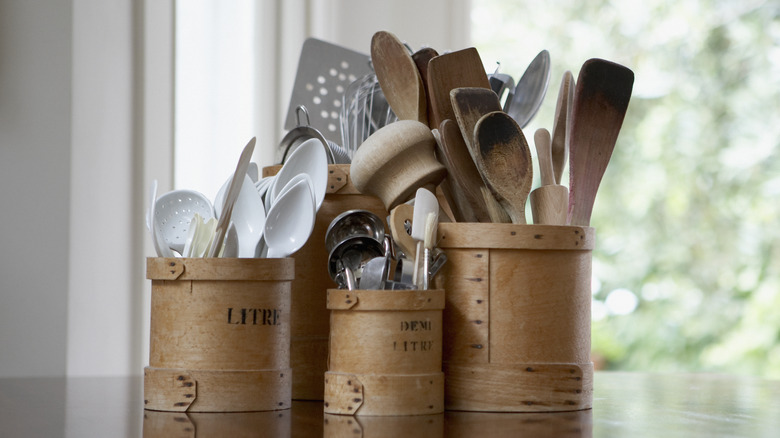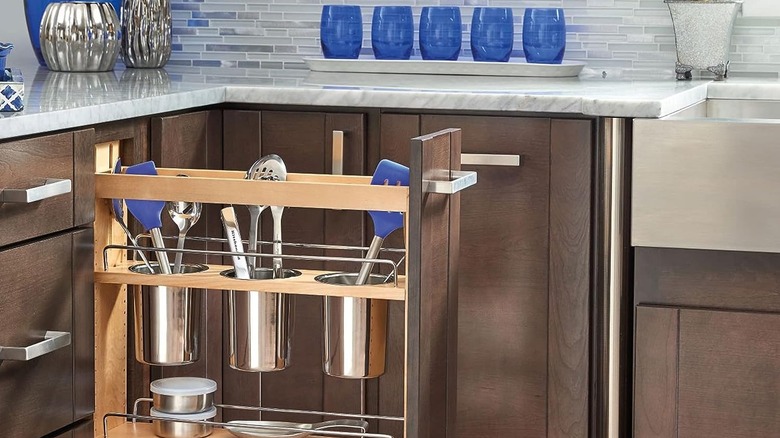TikTok's Vertical Drawer Idea Is The Simplest Way To Save Extra Countertop Space
We may receive a commission on purchases made from links.
Sometimes the solution to a problem is so obvious that you smack yourself in the forehead in a "why didn't I think of that" gesture. The problem in this case is that some people don't have the counter space, or the clutter tolerance, to have cooking utensils sitting out by their cooktops. The solution is so simple that TikTok influencers Jess and Matt (@thebrainandthebrawn) can solve it in an 11-second video that, frankly, could be half that long. (Now you're smacking yourself in the forehead in an "I could be a TikTok influencer" gesture, right?) Their solution? Put the utensils in a drawer.
We know what you're thinking: "That's not a solution, it's the thing I was trying to avoid by having them on the counter in the first place." Well, the unique part of @thebrainandthebrawn's solution is that they stow their spatulas, tongs, slotted spoons, and the like in a drawer built so they can be upright, just as they would be on the countertop. Moving things about is always an opportunity to use space more efficiently or effectively, and it doesn't have to stop with utensils; HGTV's Emily Henderson says deep drawers can free up counter space in the kitchen by storing other items, like plates, as well.
Where to get a vertical drawer
You can find pre-fab cabinets specifically designed to help you banish unsightly kitchen utensil clutter, and if you're ordering new custom cabinets you can specify an appropriate drawer and accoutrements like stainless utensil holders. But if you're buying off-the-shelf base cabinets, or modifying existing cabinets, it can get a little tricky. Many prefab cabinet systems don't include a two-drawer option and some that do only offer it for shorter desk-height cabinets.
Even counter-height two-drawer bases aren't likely to be deep enough (by "deep" we mean "tall" — cabinet depth generally refers to front-to-back distance, but many companies still talk about "deep drawers" when referring to their top-to-bottom dimensions). Drawer height varies by manufacturer, but a two-drawer, 34½-inch-tall cabinet probably won't hold long utensils vertically after you back out the height of the toe kick, the spacing between drawers, the reveals of the drawers themselves, etc. This leaves a bespoke solution for your cabinets, and that doesn't have to be as pricey as it sounds. The simplest approach might be to use roll-out trays designed to work with standard door base cabinets. To keep things from constantly flopping over, mount them high and use a hole saw or jigsaw to make cutouts to nestle your utensil holders in. You can also hire a cabinet maker to make something custom for you, but at an average of $850 per linear foot of custom cabinetry, it might be cost-efficient to build your own.
Making the vertical drawer work for you
But storing your utensils vertically, all shoved in the same container, is no more effective than dumping them all in a drawer. Where storing them vertically becomes a big win is when you do the other thing that Jess and Matt pulled off: put them in a drawer with dividers so they could separate the utensils by type. Tongs and ladles don't do the same things, so there's no reason to have to pick through a pile of both when your chicken needs to be flipped and your hands might very well be coated with salmonella. Stored vertically and by type, utensils can be picked out easily. To do that on the counter you'd need the same amount of horizontal space as a drawer, meaning that your utensils would take up at least two square feet of counter real estate.
This vertical drawer approach works best paired with a few other strategies. First, get rid of utensils you don't need. Do you really need six big spoons, four big slotted spoons, and three ladles? Second, keep things you need but rarely use out of the workflow. If you cook with those giant chopsticks all the time, that's fine; otherwise, shuffle them off to a drawer with all those garlic-related gadgets you never touch. Third, lots of things benefit from being stored vertically, like cutting boards, cookie sheets, and pot lids. And finally, don't store stabby things pointy-side-up. (Smacks forehead again.)

